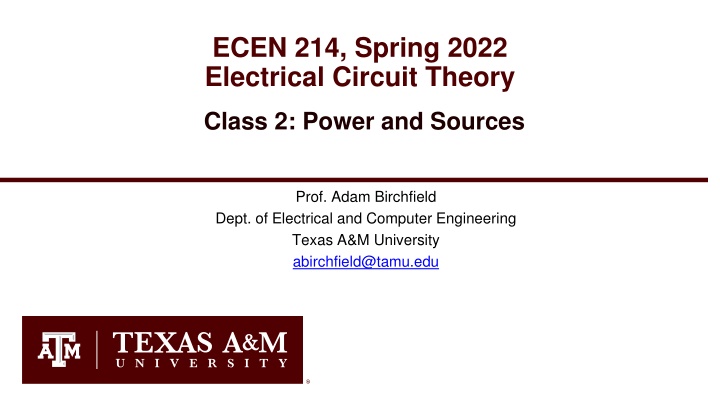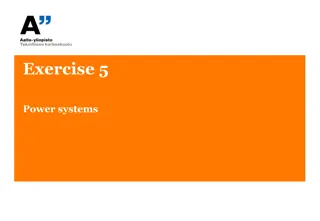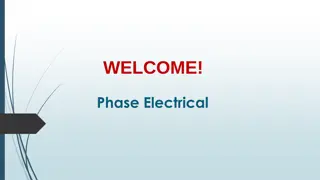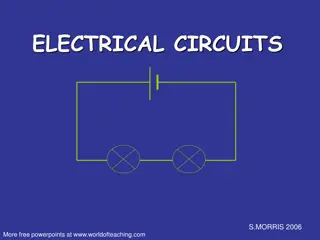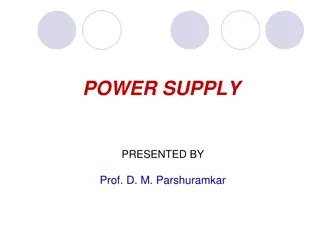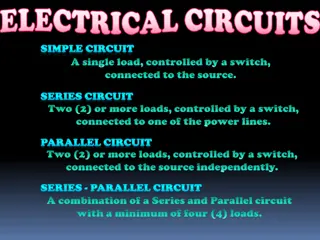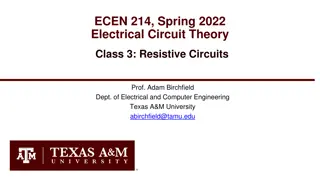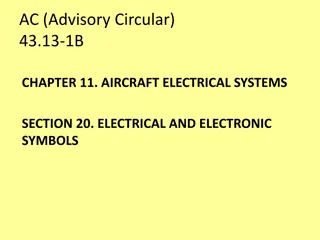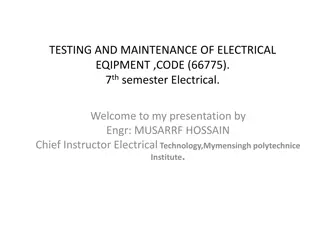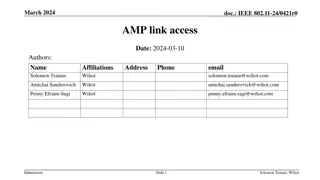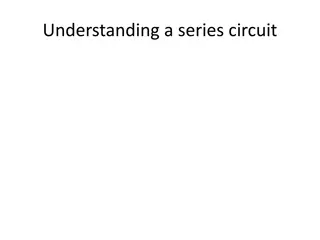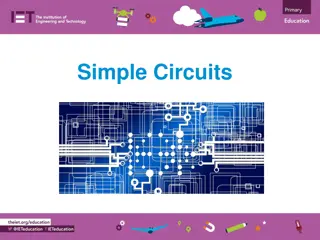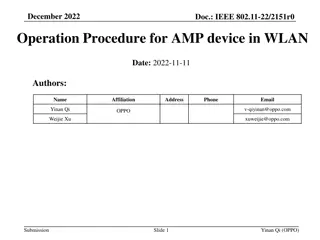Electrical Circuit Theory: Power and Sources at Texas A&M University
Dive into the fundamentals of electrical circuit theory with Professor Adam Birchfield at Texas A&M University. Explore the concepts of power and sources in this Spring 2022 course for ECEN 214. Understand the principles that underpin modern electrical and computer engineering through engaging lectures and practical applications. Develop a solid foundation in circuit analysis that will set you up for success in your academic and professional endeavors. Stay connected with the latest advancements in the field and enhance your understanding of complex electrical systems.
Download Presentation

Please find below an Image/Link to download the presentation.
The content on the website is provided AS IS for your information and personal use only. It may not be sold, licensed, or shared on other websites without obtaining consent from the author.If you encounter any issues during the download, it is possible that the publisher has removed the file from their server.
You are allowed to download the files provided on this website for personal or commercial use, subject to the condition that they are used lawfully. All files are the property of their respective owners.
The content on the website is provided AS IS for your information and personal use only. It may not be sold, licensed, or shared on other websites without obtaining consent from the author.
E N D
Presentation Transcript
ECEN 214, Spring 2022 Electrical Circuit Theory Class 2: Power and Sources Prof. Adam Birchfield Dept. of Electrical and Computer Engineering Texas A&M University abirchfield@tamu.edu
2 A Bigger Example Write out Ohm's law for each resistor and KCL and KVL everywhere in the circuit that might be useful and see if you can get a set of equations to solve for ?1,?2,?3,?1,?2,?3 ?1 _ ?1 + ?2 _ ?2 + 1 ?? + _ 2 ?3 1 ? + _ 3 ? 15 ? + _?3 5 ? 3 Bonus: what's the voltage across the 5 A current source?
3 A Bigger Example Write out Ohm's law for each resistor and KCL and KVL everywhere in the circuit that might be useful and see if you can get a set of equations to solve for ?1,?2,?3,?1,?2,?3 Solution: Ohm's law ?1= ?1 ?2= 2?2 ?3= 3?3 KCL 5 1 = ?1 1 = ??+ ?3 ?1+ ??= ?2 KVL ?3+ 3 ?2 15 = 0 ?1= 4 A; ?1= 4 ? ??= 1 ?3 4 + 1 ?3= ?2 3?3+ 3 2?2 15 = 0 3?3+ 3 2 5 ?3 15 = 0 ?3= 4.4 ?; ?3= 13.2 ? ?2= 0.6 ?; ?2= 1.2 ? ??= 3.4 ? ?1 _ ?1 + ?2 _ ?2 + 1 ?? + _ 2 ?3 1 ? + _ 3 ? 15 ? + _?3 5 ? 3 Bonus: what's the voltage across the 5 A current source?
4 Short Circuit and Open Circuit + V _ The voltage across a short circuit is zero 16? 6?? The current through an open circuit is zero
5 Example of Series Devices Elements in series share one junction, with nothing else connected to the same junction They have the same current (KCL) Resistors in series add For the circuit shown: 1. Find the current flowing through the circuit. 2. Find the voltage across each resistor.
6 Example of Parallel Devices Elements in parallel share two junctions, regardless of what else is connected They have the same voltage (KVL) 1 Resistors in parallel combine as: ? = ?1+1 1 ?2 For the circuit shown: 1. Find the voltage drops across each resistor. 2. Find the currents flowing through each resistor. 3. Find the current flowing through the voltage source.
7 Examples: Find Shorts, Opens, Parallel, Series 1 ? ?? 1 ? ?? + _ + _ + V _ + V _ + _ 30 10 ? + _ 30 10 ?
8 Another Practice Example of KCL and KVL For the circuit shown, find all voltages and currents for the three resistors.
9 Electrical Engineering Has Changed the World Two main functions of engineering Analysis break it down Design build it up What's electricity useful for? Transmitting energy the ability to do useful work Transmitting information data with meaning What makes electricity especially good for that? It is fast we can send vast amounts of energy and information at nearly the speed of light across continents (and information across oceans and space) It is efficient very little energy losses in conductors, information can be processed in nano-sized devices
10 Electrical Power Definition: Power is the rate of energy (work) expended per unit time. P =?? ?? Calculate the power produced by the source and absorbed by the resistor. (40 mW) P=power (Watts) 1 Watt =1 Joule 1 second t=time (seconds) w=work or energy (Joules) + V _ 10? 2?? Note also that ? =?? ??=?? ?? ?? ??= ? ? 1 Watt = (1 volt)(1 amp) Sign convention really matters with power! If current flows intothe terminal with the plus side of the voltage measurement (like in Ohm's law) the device is absorbing power.
11 Electrical Sources Definition: An electrical source is a device capable of converting non-electric energy to electric energy. Battery converts chemical to electrical energy Generator converts mechanical energy to electrical energy Wind turbine converts wind to electrical energy Solar cell converts sunlight to electrical energy
12 Current Sources Definition: A current source produces a constant current through its terminals regardless of the voltage across it. Independent current source produces the same current regardless of any other voltage/current elsewhere in the circuit. Voltage controlled current source produces a current which depends on ??, some other voltage elsewhere in the circuit. ? =constant of proportionality in amps/volt Current controlled current source produces a current which depends on ??, some other current elsewhere in the circuit. ? =dimensionless constant of proportionality 50mA ??? ???
13 Voltage Sources Definition: A voltage source produces a constant voltage across its terminals regardless of the current flowing through it. Independent voltage source produces the same voltage regardless of any other voltage/current elsewhere in the circuit. Voltage controlled voltage source produces a voltage which depends on ??, some other voltage elsewhere in the circuit. ? =dimensionless constant of proportionality Current controlled voltage source produces a voltage which depends on ??, some other current elsewhere in the circuit. ? =constant of proportionality in volts/amp + _ 12V + _ ??? + _ ???
14 Example of a Dependent Source Kirchhoff's Current Law 9 + 0.1?? ??= 0 9 0.9= 10 mA ? = 10 mA 10 k = 100 ? ??= ?? + ? _ Power analysis Independent voltage source producing (9 mA)(100 V) = 900 mW Dependent voltage source producing (1 mA) (100 V) = 100 mW Resistor consuming (10 mA)(100 V) = 1000 mW = 900 mW + 100 mW 10 ? 9 ?? 0.1 ?? This is conservation of energy.
15 Conservation of Energy Conservation of Energy: Total power generated = total power absorbed Circuit must be isolated from any other devices Net sum of the power of all elements = 0 Use it to check your work!
16 Example 1 of Conservation of Energy ?2 Circuit Element 2 ?2 + _ _ + ?4 + Circuit Element 1 Circuit Element 3 Circuit Element 4 ?3 ?1 _ _ + ?4 ?1 ?3 Element Voltage 1 2 3 4 Current -1mA -1mA 4mA -3mA Element 1 2 3 4 Power 3 volts -2 volts -1 volt 1 volt Total Power = 0
17 Example 2 of Conservation of Energy The numerical values for the voltages and currents in the circuit shown are given in the table below. Find the total power developed in the circuit. Element Voltage (kV) 150 150 100 250 300 -300 Current (mA) 0.6 -1.4 -0.8 -0.8 -2.0 1.2 Power (W) a b c d e f
18 Restrictions on Source Connections Voltage and current sources cannot be connected in arbitrary manners. The following examples show both valid and invalid connections. + _ + _ + _ + _ 12V 12V 12V 6V 50mA 20mA 50mA 50mA + _ 12V 50mA 50mA 50mA VALID INVALID
19 Restrictions on Source Connections Here are some more examples of both valid and invalid source connections. + _ + _ + _ 4?? 3?? ??= 3? ??= 3? + _ 4?? 3?? ??= 2? ??= 2? VALID INVALID
20 Example of Restrictions on Source Connections For the circuit shown: (a) What value of ?? is required in order for the interconnection to be valid? (b) For the value of ?? found in part (a), what is the power associated with the 8A current source?
21 Assignments Get the Zybook and complete sections 2.4, 2.6, 2.7, 2.8, 3.2, 3.3, 3.5 Due 4pm on Monday, Jan 31 If you haven t done the earlier sections that were due today, do these as well See the syllabus for details on how to get the Zybook Homework #1 on Canvas Also due 4pm on Monday, Jan 31 Take it as many times as needed, your best score will count. It is different each time, so it is good for additional practice. Review in-class examples and notes Practice, practice, practice! If the positive/negative conventions are difficult, look through the next 2 slides Quiz #2 on Wednesday
22 Passive Sign Convention Passive Sign Convention - For a two terminal element, whenever the reference direction for the current is in the direction of the voltage drop, use a positive sign in any expression that relates voltage to the current. Otherwise use a negative sign. In other words, the current should be going into the plus side of the voltage measurement I I + + Circuit Circuit V V element element - - ? = +?? ? = +??? ? = ?? ? = ??? ?? ?? ? = +??? ? = ??? ?? ?? ? = +?? ? = ??
23 Test Your Understanding In this example two circuit elements are connected together. With the voltage polarity and the direction of current defined in the drawing, for each case below determine if Element 1 is delivering power to element 2 or vice versa. I + Circuit Circuit V a) ? = 3 volts, ? = 20??, Element 1 Element 2 - b) ? = 3 volts, ? = 20??, c) ? = 3 volts, ? = 20??,
